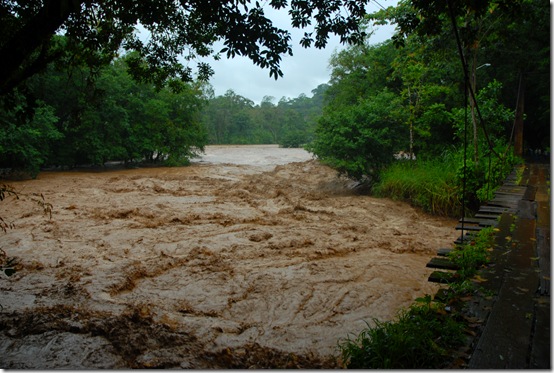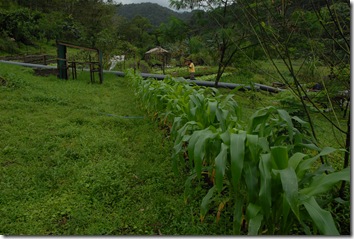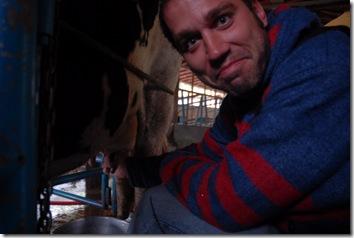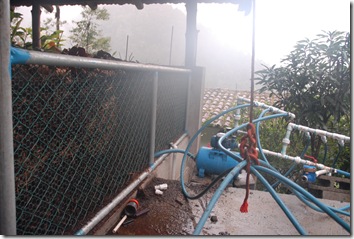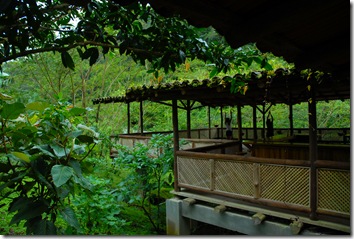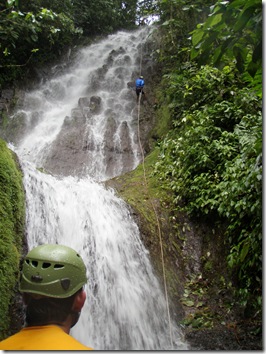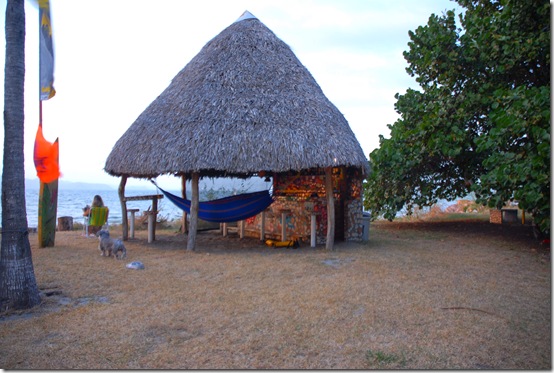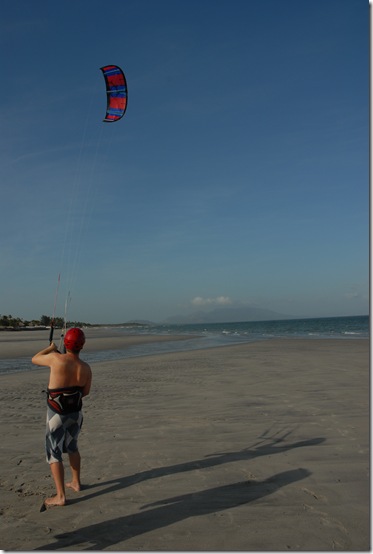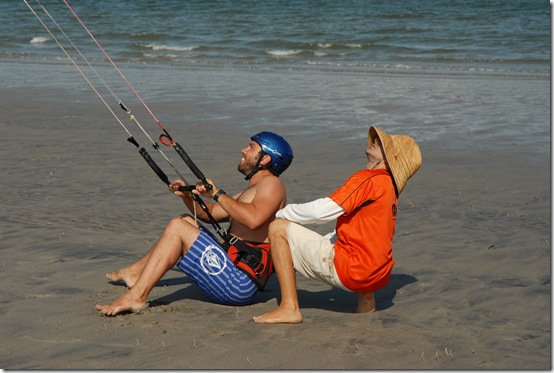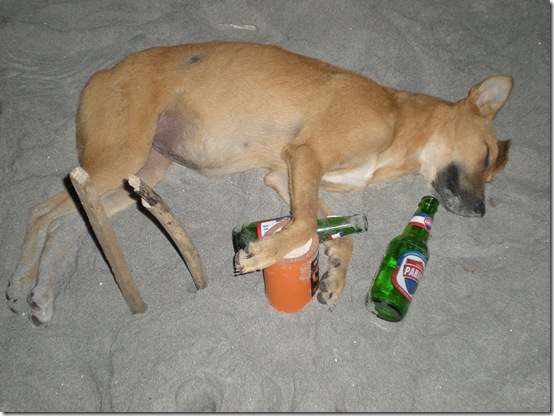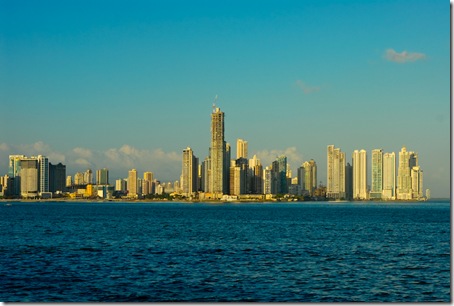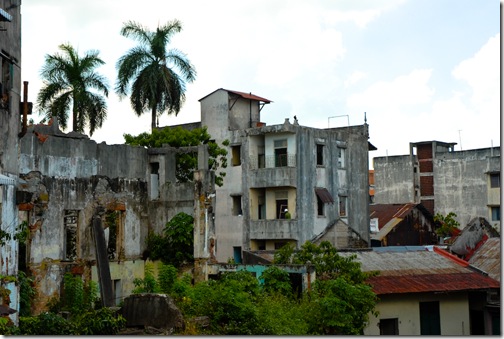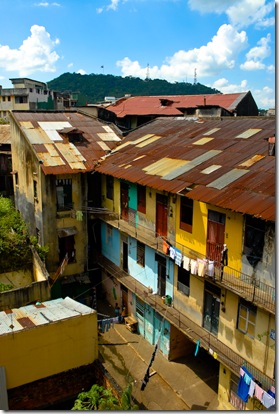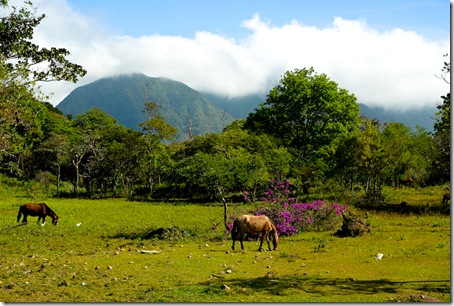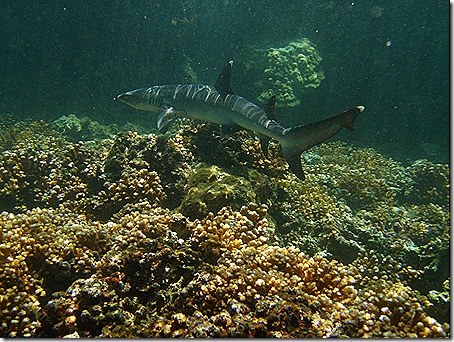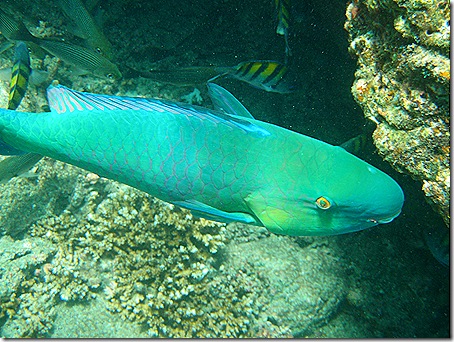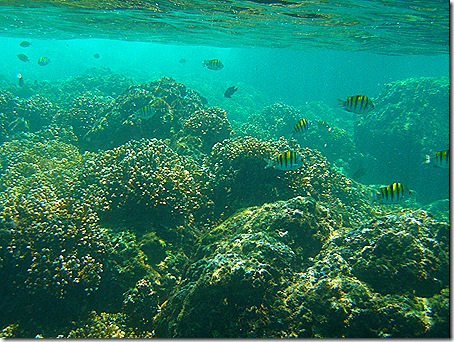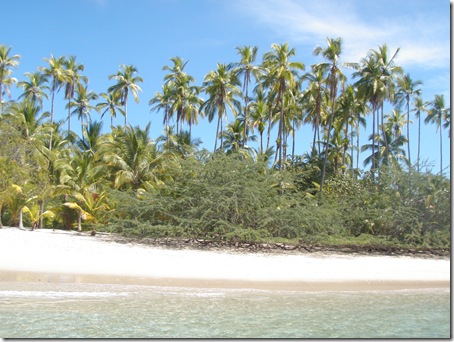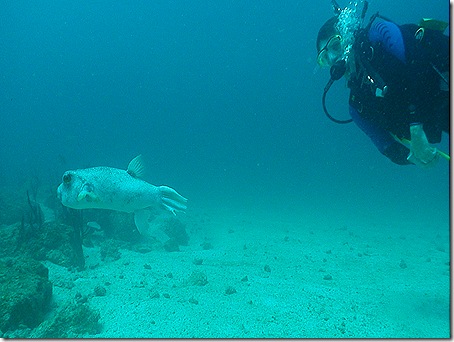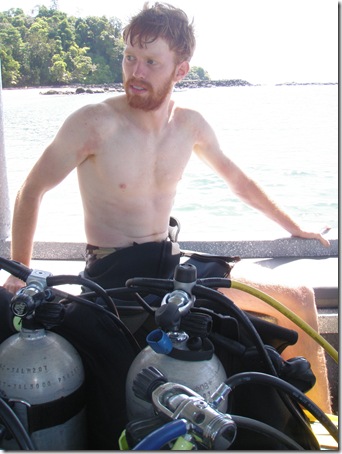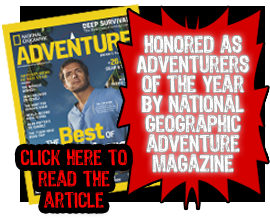Nature was definitely a factor during our stay at Chilamate Rainforest Eco-Retreat in Costa Rica. It poured rain for consecutive days and the Sarapiqui River which borders the property rose to dangerous levels and slowly ate away at the river’s banks. At times whole trees and giant logs floated by showing the sheer force of the flood water. Also seen here is the questionable looking but reliable bridge we crossed in the trucks several times. Our photos do not do justice to the the power, danger, and effects of this raging river.
Rancho Margot
By Melissa Terry in
To date, one of our most recommended stays in Latin America is without a doubt, Rancho Margot. The ranch maintains nearly 400 acres tucked snuggly on the banks of the Rio Cano Negro as it flows into picture-perfect Lago Arenal. There is something for everyone at this family run ranch, be it adventure, relaxation, education or all three.
We first heard of the ranch through friends who found the ranch as listed on the WWOOF (World Wide Opportunities on Organic Farms) database. After their 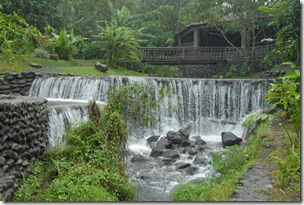 month long work-stay, they were so amazed by their experience that they practically begged us to swing by. Although the famous rain of the Costa Rican rainforest hardly let up during our 3 night stay, we were amazed too. We were immediately welcomed by a friendly staff who served us our welcome drinks as we sat down to lunch. The cuisine is sophisticated and fresh. An important part of the self-sustainability of the ranch are their gardens which provide the majority of produce utilized in the kitchen. Aside from vegetable, herb and fruit gardens, they also tend to dairy cows, pigs and free range chickens as they aim to to produce everything to be consumed both customers and employees. Soon to come is the ability for guests to purchase any cheeses, butter and meats made in house. For the time being, any overnight guest is more than welcome to gain first hand insight by participating in any of these processes. In fact, guests are encouraged to inquire and satisfy any curiosity about all aspects this self-sustainable, organic ranch-and there is a lot to be learned. A large part of this self-sustainability is the energy produced on site. Hydro electricity produced from a micro turbine powers the ranch while the newest project is a biodigester that will draw natural methane gas from organic waste which can then be used as generator fuel or used as a substitute for propane as a heating agent.
month long work-stay, they were so amazed by their experience that they practically begged us to swing by. Although the famous rain of the Costa Rican rainforest hardly let up during our 3 night stay, we were amazed too. We were immediately welcomed by a friendly staff who served us our welcome drinks as we sat down to lunch. The cuisine is sophisticated and fresh. An important part of the self-sustainability of the ranch are their gardens which provide the majority of produce utilized in the kitchen. Aside from vegetable, herb and fruit gardens, they also tend to dairy cows, pigs and free range chickens as they aim to to produce everything to be consumed both customers and employees. Soon to come is the ability for guests to purchase any cheeses, butter and meats made in house. For the time being, any overnight guest is more than welcome to gain first hand insight by participating in any of these processes. In fact, guests are encouraged to inquire and satisfy any curiosity about all aspects this self-sustainable, organic ranch-and there is a lot to be learned. A large part of this self-sustainability is the energy produced on site. Hydro electricity produced from a micro turbine powers the ranch while the newest project is a biodigester that will draw natural methane gas from organic waste which can then be used as generator fuel or used as a substitute for propane as a heating agent.
Again, there is a lot can be learned about organic farming and self-sustainability at Rancho Margot. While their staff is well informed on all matters concerning the ranch, a stay is not complete without a chat with the mastermind behind it all, Juan Sostheim. He has dabbled and succeeded greatly in many ventures worldwide and decided upon this particular investment as an eager development in wildlife conservation and reforestation. With that one of the first of many projects was born, the Rancho Margot Ranger Station for the Children’s Eternal Forest. Also under the umbrella of their conservation program is a wildlife rescue center. If you couldn’t already tell that Mr. Sostheim is a great philanthropist going above and beyond, he also admitted that “sure, it’s costs more time and money to make all the furniture here on the ranch, but I like creating jobs.”
By educating tourists and locals alike, Rancho Margot is actively pursuing its pledge to “be recognized as the best conservation, educational, adventure working ranch in Latin America…in order to create a better world for the future generations.”
Besides enjoying the great company of the Sostheim family and the inspiration they have created, TWBR also spent some time climbing, rappelling, horseback riding and daily yoga all in one of the most peaceful places in the region.
The vast expanse of gardens.
Steve doing his part, and loving it.
The Biodigester.
Evening yoga.
Melissa rappelling down the 40m waterfall.
Nels’ Notes: Nomadic Wandering Shenanigans
By Nels Thoreson in
This is Nels’ first attempt at summing up the week. It is actually my fault that it is up a week late as we were out of internet contact for the last few days and I forgot get it posted before we got out of contact. So this one if for a week ago and another one will be up in the next day about this last week. ~ Steve S.
February 9, 2009-February 13, 2009
Countries: Costa Rica, Nicaragua, Honduras, El Salvador
Miles Driven: 689 kilometers or 428 miles
Song of the Week: “Troubleâ€-Ray Lamontagne
Book of the Week: “On The Roadâ€-Jack Kerouac
On the Road (Penguin Classics)
Quote of the Week: “We better stock up on Doritos because you know you don’t want to take your chances with the roll the dice chips at the border.â€-Steve Bouey explaining to us the quality and selection of local chips.
On Monday we said farewell to the gracious owner, Juan and staff at Rancho Margot. Their combination of beautiful scenery, excellent food/service and sustainable projects makes it a must visit in central Costa Rica. Next came the relatively simple Nicaraguan border crossing, where we put Steel on a bus to catch a flight to Phoenix to work at the NBA-All Star Game. Our first stop in Nicaragua was the beautiful house named Villa Noche, in San Juan del Sur in Nicaragua. It is the vacation rental house of the owner of Aquaholic, the deep sea fishing company that would be taking us fishing on Wednesday, who we later found out is ex-NBA player Travis Knight. This proved to be the most relaxing couple of days we had in weeks in quite possibly the nicest house any of us have ever laid foot in.
 The crew awoke Wednesday with deep sea fishing on our minds. We took to the sea, but it wasn’t fishing season, and that became quickly apparent. Our boat trolled the coast for 5 hours, and luck wasn’t on our side. The experience was not a failure, however, for our captain and assistant were great, and you can’t beat a stroll on the sea with the sun on your face and wind at your back. After fishing we got in the trucks and made our way north to Lake Xiloe for the night. A random local guy we talked to on the street led us to his friend’s restaurant/bar who let us camp on has lakeside property for the night. We set up our big tent right on the dance floor. It seemed like the right place to rest our heads.
The crew awoke Wednesday with deep sea fishing on our minds. We took to the sea, but it wasn’t fishing season, and that became quickly apparent. Our boat trolled the coast for 5 hours, and luck wasn’t on our side. The experience was not a failure, however, for our captain and assistant were great, and you can’t beat a stroll on the sea with the sun on your face and wind at your back. After fishing we got in the trucks and made our way north to Lake Xiloe for the night. A random local guy we talked to on the street led us to his friend’s restaurant/bar who let us camp on has lakeside property for the night. We set up our big tent right on the dance floor. It seemed like the right place to rest our heads.
On Thursday we drove all day and finished in El Cuco, El Salvador. That means two border crossings. The first was in Honduras. It was here that Steve S. found out that his afternoon would consist of photocopying every piece of paper he could find. One to go here, one to go there, and one to probably start a fire later that night. The efficiency at the border was remarkable. Steve was also notified that our short drive through Honduras to get to El Salvador cost $40 per vehicle, and there was no room for discussion.  Upon entering Honduras we found out that the $20 per vehicle portion was “permission†to drive in Honduras on their terrible roads covered with potholes, but even with our $20 permission were very pleased to be stopped every 10 minutes for attempted hustles by the Honduras police. We arrived at the El Salvador border with hopes of a quick enter, but again, photocopying is a high priority, so Mr. Shoppman had two nice quarter- mile walks to the copy machine so we could leave. We arrived late in El Cuco, ate at an elderly lady’s restaurant. Steve S. asked her about a place to camp and knew she was in charge when she ordered the two policemen eating in her cafe escort us to a beach spot where we camped for the night.
Upon entering Honduras we found out that the $20 per vehicle portion was “permission†to drive in Honduras on their terrible roads covered with potholes, but even with our $20 permission were very pleased to be stopped every 10 minutes for attempted hustles by the Honduras police. We arrived at the El Salvador border with hopes of a quick enter, but again, photocopying is a high priority, so Mr. Shoppman had two nice quarter- mile walks to the copy machine so we could leave. We arrived late in El Cuco, ate at an elderly lady’s restaurant. Steve S. asked her about a place to camp and knew she was in charge when she ordered the two policemen eating in her cafe escort us to a beach spot where we camped for the night.
Luckily the Friday morning tide didn’t wash our campsites away on the beach, so we headed to the exact opposite end of the spectrum. That day we awoke going to the bathroom in the woods, and ended up at a five-star resort that night. Four hours of driving put us at our destination of the Decameron All Inclusive Resort on the Pacific Coast in El Salvador. The list of activities ranges from scuba diving in a volcano crater to Mayan Ruins trips. Pools, hot tubs, restaurants, bars, a gym and spas scatter the property. We settled in, went for a swim, and then had a World By Road family dinner at the Bambu Restaurant that specializes in Thai food. A few beverages followed, along with some dancing with a bunch of middle-aged/later-aged tourists. We pushed on until midnight to celebrate Craig’s birthday, but soon after took advantage of the comfy beds waiting for us that night.

Special Thanks:
Juan Sotheim at Rancho Margot
Travis Knight at Villa Noche/Aquaholics
The Day the Wind Died
By Craig Johnson in
So we’re safe and sound in Panama AND we finally have re-claimed the vehicles. What do we do next, why not try some kiteboarding. Luckily, our new friend Itzick Lalo, of Machete Kiteboarding was up for giving us a lesson or two. Kiteboarding is a water sport that uses the power of the wind to pull the rider through the water on a small surfboard, more similar to a wakeboard. A kiteboarder uses a board with or without foot-straps or bindings, combined with the power of a large controllable kite to propel himself and the board across the water.
Machete Kiteboarding School is located on Punta Chame, a somewhat isolated peninsula about 1.5 hours away from Panama City. Apart from being a great place for kiteboarding during the season, which runs from November to April with the peak months being December to February, Punta Chame is just a great place to chill out for a while.
There’s plenty of hammocks to relax in during the heat of the day. At night you can build a bonfire on the beach with the abundant driftwood, which we proceeded to do to excess. With no city lights around, you can watch for shooting stars and enjoy the peace and quiet. There’s a few places to eat and grab some drinks in a small village nearby. For camping purposes I’d recommend bringing your own food and water along which you can pick up before turning off the main highway. If one were so inclined, there’s also a semi-upscale hotel located next door to Machete for those wanting a little more creature comforts.
Kiteboarding, like surfing, takes time, patience, and the cooperation of nature; which in this case is the wind. Itzick likes to instruct his students one on one, with the initial lesson lasting up to 6 hours. The wind picked up just enough in the early morning for Steve S. and I to give it a try. While the first lesson is on the beach without a board, you’re still harnessed into the kite in order to get a handle on how to safely and efficiently use the wind. Steve and I learned about the proper angles of the kite to the direction of the wind, turning, and the very important method for starting. Apparently, the wind had been steady and strong for a month. Unfortunately for us, it decided to take a few days off.
Sports that rely on nature can be very difficult and time consuming to learn. With the road always calling on us to move a little further towards home, we just didn’t have enough time. Thanks to Itzick for giving us a shot and hosting us at his awesome property. Good Winds!
Â
One of many hammocks
Practicing on the beach
Steve has to crawl before he can run
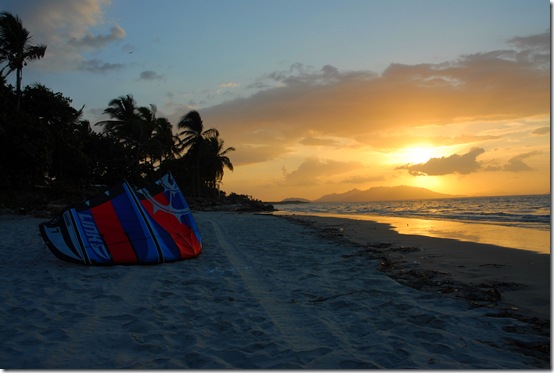
Sunset at Punta Chame
Current Events in Central America
By Melissa Terry in
Here is a brief look at some of the things making news in this part of the world:
* Nicaragua has long been a country of rolling black-outs. As of the first of the year they are desperately trying to quell that problem by introducing a $90 million wind derived energy project. The 19 windmills have the potential to offer more than 6% of the nation’s energy needs by producing 40-megawatts of energy. Already this current project is slated to save the country over $9 million a year in fuel costs and is allowing for the development of another 40-megawatt instillation. Nicaragua is not only seeking wind energy, but geothermal energy from surrounding volcanoes and hydroelectricity from their rivers as they attempt to reduce dependency on foreign oil. Already those other projects are responsible for 34% of the nations energy and increasingly promising the goal to have reliance on oil to 3% by 2013.
*Orlando “Cachaito” Lopez, of renowned Cuban group, Buena Vista Social Club passed away last Monday at the age of 76 due to complications of prostate surgery in his native Havana, Cuba. As he was the bass player, he was widely considered the “heartbeat” of the group. Like many of the original line of of members, Lopez was in his musical prime in the 1950s and 1960s and only forming in 1997 with their debut album titled “Los Superabuelos” (The super grand-fathers. Soon after several of the musicians were re-paired to record the self-titled album that quickly received international attention and acclaim and now considered ” a classic.”
*Clean up efforts are slowly but surely coming along after last month’s 6.1 earthquake that struck in central Costa Rica. The earthquake’s epicenter was approximately located 30km NNW of the country’s capital of San Jose and 80km ENE of beach town Punta Arenas and was felt all over the country and in parts of Nicaragua. Unfortunately the earthquake claimed 34 lives and injured nearly 100 as it struck at 1:30pm. Most of the deaths occurred when a massive landslide was caused near La Paz waterfall. Many homes were ruined and over 1,000 people have been displaced. Thankfully, national and international state-affiliated and NGOs are pitching in to get the Sarapiqui region back on it’s feet. Most recent to join the cause are organizations from Chile and Spain. Chilean NGO Un Techo Para Mi Pais (A Roof for my House) will return with more volunteers to help build temporary wooden houses for those that have since found themselves homeless and Spain has announced to donate $285,000 to the relief effort while also pledging to offer more help.
*According to a recent study conducted by the World Health Organization, nearly half of Guatemala’s children are suffering from malnutrition. The average number is 45.6%, where in rural areas where poverty is more common than not, the number jumps to 49.7%. Another recent study showed that of the nation’s population of 13 million, 52% are living in either poverty or extreme poverty.
Living The Jungle Dream
By Nels Thoreson in
“Welcome!†exclaimed owner, Davis, with a smile from ear to ear. He has many reasons to smile these days, for what started as a dream has now turned into reality. He and his wife, Meghan, are the proud owners of the Climante Rainforest Eco-Retreat in the Chilamate, Sarapiqui region of beautiful Costa Rica.
 Their amazing 50 acre property of Sarapiqui Tropical Rainforest is both a reserve and wildlife refuge, and also a great place to learn and teach. The natural landscape enable students, both local and international, to explore and study biodiversity, conservation techniques, and reforestation.
Their amazing 50 acre property of Sarapiqui Tropical Rainforest is both a reserve and wildlife refuge, and also a great place to learn and teach. The natural landscape enable students, both local and international, to explore and study biodiversity, conservation techniques, and reforestation.
Their family bought the reserve in 2000 from Don Lindley Lumsden who protected the land for more than 60 years by standing up to poachers and people wanting to cut down the trees, pasture the land and use through development. The property came with beautiful gardens, basic housing accommodations, and a basic kitchen, but Davis’ mastery of carpentry turned basic into unbelievable. The main lodge, kitchen, walkways and cabins that he created by hand are beyond esthetically pleasing. One can see the hard work and dedication in the various handcrafted items he has built. Everything is made on the property or bought locally, only adding to the impressiveness of its sustainability.
 Their projects, passion, service, dedication, effort on conservation and sustainability are very admirable. They use solar power, organic food grown from their property or food bought from the locals. Their family involvement in the project and their connections in the community bring everything together. The Sarapiqui area functions as one, with different organizations and companies promoting each other and directing tourists to each other. With activities ranging from rafting to cooking classes, massage to yoga classes a stay here proves to be more than just a few quiet nights in the jungle.
Their projects, passion, service, dedication, effort on conservation and sustainability are very admirable. They use solar power, organic food grown from their property or food bought from the locals. Their family involvement in the project and their connections in the community bring everything together. The Sarapiqui area functions as one, with different organizations and companies promoting each other and directing tourists to each other. With activities ranging from rafting to cooking classes, massage to yoga classes a stay here proves to be more than just a few quiet nights in the jungle.
Our experience here allowed us to witness the magnitude of nature. The area’s focal point is the Sarapiqui River, and due the big earthquake a month prior to our arrival upstream, the river was raging, knocking down entire trees and destroying banks. To all of us this seemed like an impending disaster but Davis saw things differently saying, “It’s nothing, man, it’s just nature. It may have taken away some of my property, but the river is wider, which is good.â€
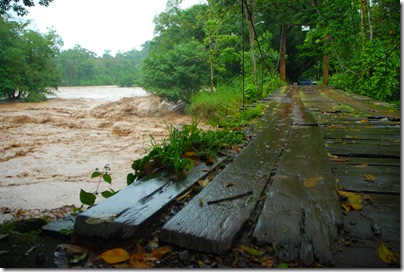 With great accommodations, hospitality, scenery and service our stay in the jungle truly encompassed the famous Costa Rican slogan, as Davis would recited, “Pura Vida!â€, which translates to “Pure Life.â€
With great accommodations, hospitality, scenery and service our stay in the jungle truly encompassed the famous Costa Rican slogan, as Davis would recited, “Pura Vida!â€, which translates to “Pure Life.â€
Photo of the Week: Windy
By Craig Johnson in
There are a lot of stray dog’s in Central America. Some are dangerous, some are indifferent, and some are extremely friendly. This little sweet dog we met at Machete Kiteboarding at Punta Chame, Panama is nicknamed Windy. She passed out early while we all enjoyed the bonfire on the beach.
Just What Is Really Going On In Panama?
By Steve Bouey in
Panama is a country of contrasts, probably more so than any other country I have traveled through on this expedition. There are definitely a lot of other countries in the world where you can see the stark contrast between rich and poor, the haves and have nots but because Panama is such a small country relatively speaking, these contrasts can literally be observed without really going anywhere or even trying. In some countries you might have to drive the entire length of the country to witness the varying social classes and the differences in how people live. In other countries, the the visible indicators of poverty are more sheltered and hidden from view. In Panama though, everything seems to be mixed together. Signs of wealth appear to be evenly interspersed with a lack thereof.
Panama has money, and this money comes from a diversified variety of sources. Probably the most prominent source of Panama’s wealth comes from the Panama Canal. For a modern, average sized container ship to pass through the canal locks and transit from the Pacific Ocean to the Atlantic, a tax of as much as $240,000 must be paid. Shipping companies gladly pay this transit fee in order to drastically cut down on the costs associated with sailing all the way down and around South America. Considering more than 20 of these large vessels pass through the canal on a given day the canal provides a revenue stream amounting to several billion dollars a year. If you add in all of the jobs and secondary business opportunities created by the presence of the canal you are talking about a lot of money. Additionally, as a result of favorable laws, Panama is also a hub of international offshore banking and this is also a powerful economic generator for the country with branch offices of every major bank in the world scattered throughout the country.
You can see the results of the wealth generated in Panama in the skyline of Panama City. If you did not know any better, you might just think you are looking at the skyline of any major US city. It is not just Panama City’s skyline that resembles and reflects that of a counterpart somewhere in the US… TGI Friday’s, Hooters, Baskin Robins, and all of the other major restaurant chains are represented there.
Panama City Skyline
Panama City
However, it does not take long to see that there are a lot of people in Panama City and elsewhere that are struggling to survive. Million dollar properties sit adjacent to ramshackle houses made out of whatever materials the builder can scavenge. Once proud and magnificent Spanish colonial mansions lay in ruin while new concrete and glass high rises are constructed in the distance. The highway system that weaves its way throughout Panama is in shambles, with the appearance of not having been maintained since the roads were constructed decades ago. Panama’s second largest and the mostly forgotten city of Colon is a depressing place yet strangely enough, it is the home of Panama’s largest duty-free shopping complex. In Colon, squatter’s shacks sit beneath billboards advertising expensive watches and designer clothes.
Not everyone is in shipping or offshore banking
So, with apparently so much wealth and so much potential wealth to go around, why are there so many visible signs of problems throughout Panama? Is is a shaky political past? Is it poor leadership and government mismanagement? Whatever the reason may be, it is obvious that Panama has some issues to face and you do not need to scratch beneath the surface to see that problems exist. Do not get me wrong, there are a lot of nice things about Panama… the people are friendly, it is home to some great natural beauty and it has a very interesting history, but after spending some time there, one can not help but scratch their head and wonder just what is really going on in Panama and more importantly, just where is all of the money going.
Social issues aside, Panama does have a lot to offer
INSERT_MAP
Scuba Coiba and Santa Catalina, Panama
By Melissa Terry in
Our last destination in Panama was a sleepy town called Santa Catalina. Surfers first came sometime in the early 80s and not much has been developed since, aside from a few restaurants, hostels and cabins. This would be a good place to come “to get away from it all” as there is zero cell phone service or internet access. For better or for worse, it’s a seemingly odd little vortex of a tropical town and no one in it, tourist or otherwise, has any clue what is going on. After about 45 minutes trying to look for our hostel on one of only 3 dead-end dirt roads, our friends Tom and Steve mentioned that they met someone in the Panama City airport who told them that the town is “really confusing”. This could not be more true…so much so that it actually warrants a warning to fellow travelers. You know then that the town is going to mess with your head. Beyond trying to communicate in any manner with anyone who’s been there longer than a few weeks, the place (and surf) is awesome and goes highly recommended! Oh, by the way we did find our hostel, Casa Dos Palmas and it had an amazing view of the ocean, sunset and the surf below.
However we did have the great pleasure of getting to partake in two amazing dives with Santa Catalina’s own Scuba Coiba, spending a whole afternoon under the waves of Panama’s Pacific coast. Divers world wide are aware of what this particular strecth of subacuatic terrain has to offer, whether or not they have ventured to experience it themselves. Coiba island is just one part of a national park that also contains 9 other islands, over 215,000 hectares of sea and also home to the largest coral reef in the eastern Pacific.
Our dives with Scuba Coiba were quite the change from our last group dive off the coast of central Chile where the water temperature was barely 9 degrees Celsius, the visibility rarely over 5 meters (usually around 1-2 meters) and where the currents were strong enough to send grown men (we’ll go with Steve S on this one) flailing in between giant boulders like worthless pieces of kelp. The overall poor conditions of that dive forced us back to the surface about 15 minutes early. But that was last time, not this time. This time the water temperature was a cozy 26 degrees Celsius and the visibility up to 20+ meters at certain locations. Dive sites throughout the Chiriqui gulf have been hailed at having some of the most promising dive experiences, in that you are most likely guaranteed to see not only more fish that previous tropical dives, but bigger and more colorful. We were not let down. The only slight disappointment is that a massive whale shark has repeatedly been spotted in the neighborhood, but unfortunately didn’t come around for either of our days’ dives.
Check out some of the pictures that we were able to take and stay tuned for the video from the dives.
We saw plenty of Reef Sharks.
A big, colorful fish
The reef
Shores of Coiba island
Bouey?
And last but definitely not least: Steel Zissou, mentally prepping himself
Photo of the Week: Sleepy Newbie
By Craig Johnson in
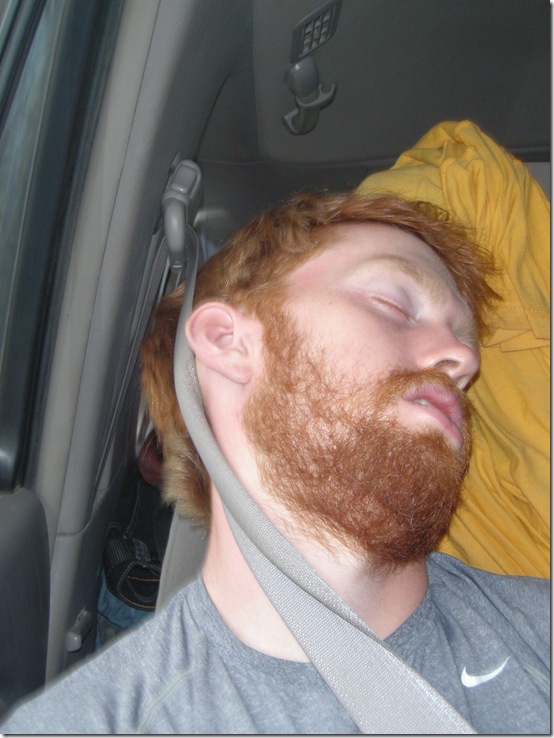
Life on the road often involves late nights followed by long days of driving. New crew member Steel Henessey Jones is pictured here catching up on his beauty sleep. Our trip this day took us from Dominical, on Costa Rica’s pacific coast, to Chilamate Eco-Retreat, in the heart of the rainforest.
